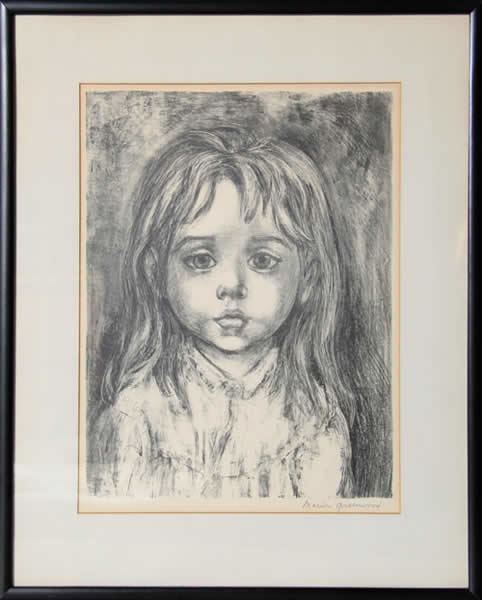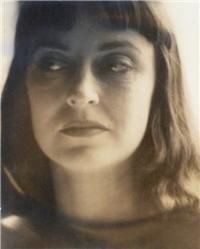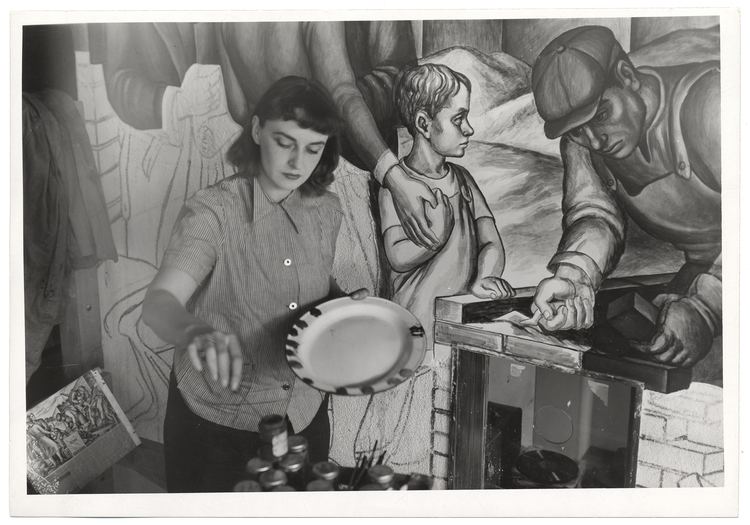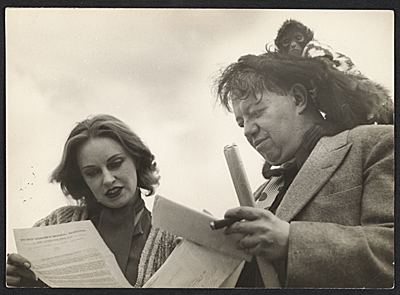Nationality American Name Marion Greenwood | Role Artist Movement Social realism | |
 | ||
Known for Murals, Painting, Lithography Education | ||
Marion greenwood in tennessee
Marion Greenwood (April 6, 1909 – August 20, 1970) was an American social realist artist who became popular starting in the twenties and became renowned in both the United States and Mexico. She is most well known for her powerful murals, but she also practiced easel painting, printmaking, and frescoes.
Contents
- Marion greenwood in tennessee
- UT displays Marion Greenwood murals
- Education
- Career
- Later life
- Work
- Awards
- References

UT displays Marion Greenwood murals
Education

Marion Greenwood was born in Brooklyn in 1909. She exhibited artistic talent at a very young age and left high school at the age of fifteen to study with a scholarship at the Art Students League. There she studied with John Sloan and George Bridgman. She also studied lithography with[Emil Ganso and mosaic with Alexander Archipenko. At eighteen, she made multiple visits to Yaddo in Saratoga Springs, New York. There, she painted portraits of intellectuals-in-residence and gained experience and knowledge through conversation. Still in her teens, Greenwood used the proceeds from a portrait of a wealthy financier to begin her travels through Europe. While she was there she studied at the Academie Colarossi in Paris.
Career

She returned to New York in 1930, but continued to travel extensively over the next four decades, mostly throughout the United States, Mexico, and China. The first visit to Taxco, Mexico in 1932 marked a crucial turning point in her career, she worked on fresco murals for the Mexican government. Between 1933 and 1936, Greenwood and her sister painted five separate murals in Taxco and Morelia, Mexico. There she met the artist Pablo O'Higgins, who introduced her to fresco painting. As a result, she began focusing her efforts on fresco-mural painting. She completed her first fresco on the stairwell at the Hotel Taxqueño. The success of this piece led to commissions from the University of San Nicolas Hidalgo in Morelia, and the Abelardo L. Rodriguez Market in the historic center of Mexico City. Greenwood was the first woman to receive a mural commission from a foreign government. Shortly after these projects, she returned to the United States to create a mural for the social hall of the Westfield Acres Housing Project in Camden, NJ. In 1937 she was hired to teach fresco painting at Columbia University, and a year later was commissioned by the Section of Fine Arts to paint an oil mural for the post office in Crossville, Tennessee. In 1940 she was commissioned by the Federal Art Project to paint frescoes for the Red Hook housing project in Brooklyn. This project, titled Blueprint for Living, was meant for low-income citizens in government housing and expressed optimism for a more harmonious future.

At the start of World War II Greenwood was one of only two women appointed as an artist war-correspondent. During this time she painted the reconditioning of wounded soldiers. This sometimes involved being present at surgeries to sketch and following the patient through to occupational therapy. The paintings, drawings, and etchings from this series are now in the official archives of the U.S. War Department.
Around 1940, Greenwood began to focus on easel painting and printmaking, generally depicting powerful, gritty scenes of working classes or insightful portraits. From 1944-46 she lived and worked in China, and she made her solo debut with pieces from her one-year stay in Hong Kong at the galleries of Associated American Artists. Another two exhibitions were held in December 1947 and March 1948. After this she was exhibited in numerous solo shows at the American Contemporary Artists Gallery. She has also been exhibited at the Corcoran Gallery in Washington, the Whitney Museum in New York, the MoMA, and the New York World’s Fair. She traveled to Hong Kong, India, the West Indies, and North Africa depicting peoples of different cultures and ethnicities and paying special attention to oppressed people in underdeveloped locations. The University of Georgia added one piece of her work from the Associated American Artists Gallery and her works are in the collections in the Metropolitan Museum of Art and the Newark Museum. In 1954 she received another large commission for a mural, The History of Tennessee, in the student center auditorium of the University of Tennessee in Knoxville. Her last mural was made in 1965 at Syracuse University. This mural was dedicated to women of the world and combined drawings and paintings from her studies and world travels.
Later life
At the end of her life she lived in Woodstock, New York with her husband Robert Plate. She died at the age of 61 on August 20, 1970.
Work
Her first trip to the Southwest began a theme in her work which involved depicting ethnic types in different parts of the world. As she visited different locales throughout her life, Greenwood would spend time learning about the people there and use them as subjects for drawings and paintings. When creating large murals later on, Greenwood would often use these studies to place figures in a larger composition. An example of her process is evident in the preparation for the decoration of the University of San Nicolas Hidalgo in Morelia. She spent a year studying and immersing herself in the Tarascan Indians culture before completing this project.
Her work during her Mexican Mural period was revolutionary in theme and was influenced by the stylization of José Clemente Orozco and Diego Rivera in its cartoonish figures and dynamic compositions.
Subjects- Greenwood’s murals were often large dramatic scenes with groups of people engaged in cultural practices or in the case of a social works project, workers in their environment. Often the murals had themes of optimism, democracy, and diversity. For example, Rehearsal for African Ballet depicts a group of African-Americans playing music, singing, and dancing together. In Blueprint for the Living, workers are laying bricks and building while a family looks upon the construction.
Beginning in 1940, Greenwood focused on easel painting and smaller works. The subjects from this period were mainly portraits of people, often lower class individuals toiling in work or squalor from foreign regions as well as in America. Greenwood was applauded by critics for “her profound sympathy with the poor and the oppressed of all lands, her natural democratic feeling” and “her disregard of difficulties and class barriers”. She was seen as an advocate for these struggling figures in the same way that she supported social movements with her social realist murals.
In her work she employed multiple mediums: oil paint, fresco, lithography, etching, charcoal, and ink.
Awards
Her works are represented in the permanent collections of the Museum of Modern Art, the Library of Congress, New York Public Library, the Bibliothèque Nationale, Pennsylvania Academy of Fine Arts, the Tel Aviv Museum, Yale Museum, Boston University, the Butler Art Institute, Newark Museum, Mint Museum, Montclair Art Museum, Norfolk Museum, National Academy of Design, New Britain Art Institute, John Herron Art Institute and Smith College. She is also in the private collections of Maurice Wertheim, Joseph Hirschorn and Marc Sandler.
